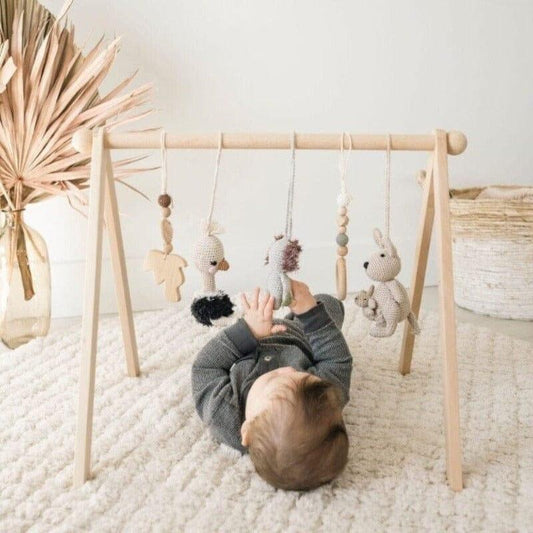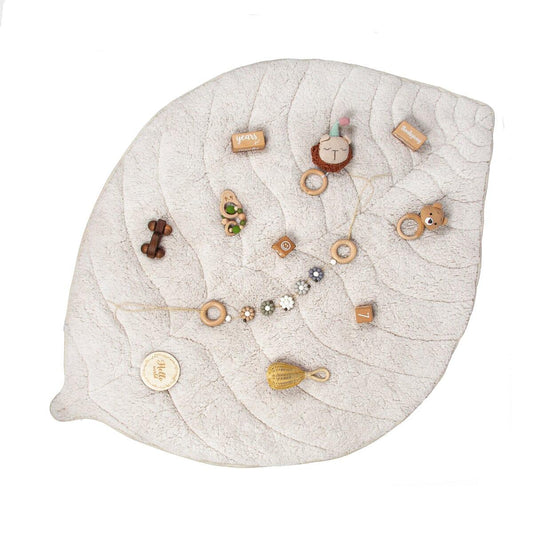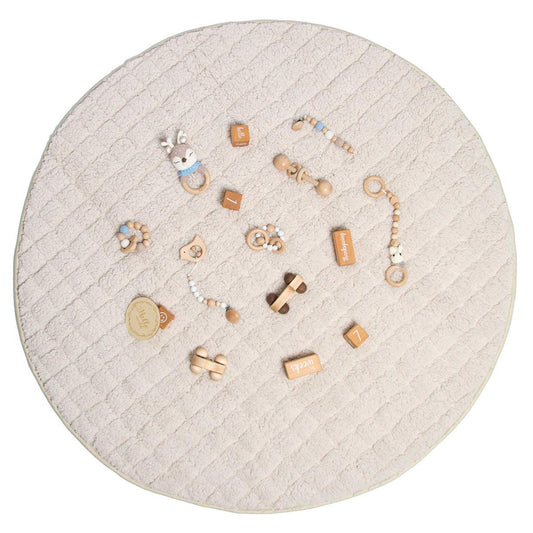Article Information:
Updated:
Excerpt:

You may also like:
8 Enjoyable Indoor Activities for Your Energetic Toddler
Looking for some fun indoor activities to keep your toddler entertained? Check out our list of 8 enjoyable indoor activities that will help burn off some of that extra energy!
6 Tips for Safely Trimming Your Toddler's Nails
If you're like most parents, the thought of trimming your toddler's nails probably fills you with a bit of dread. But it doesn't have to be a scary experience! Here are six tips for safely trimming your toddler's nails.
Experts Recommend Adopting This Habit When Communicating with Your Toddler
Experts recommend adopting this habit when communicating with your toddler to help them feel more comfortable and improve their language skills.
3 Steps to Establishing Toddler Boundaries with Empathy
It can be tough to establish boundaries with a toddler, but it's important to do so with empathy. Here are three steps to help you get started.
3 Subtle Indicators of Your Toddler's Developing Language Skills
It can be tricky to know whether your toddler is on track with their language development. However, there are some subtle indicators that can give you a clue. Here are three of them.
The Timeless Appeal of Pull Toys
There's something special about pull toys. They've been around for centuries, and yet they still hold a place in the hearts of children and adults alike. Maybe it's the simplicity of their design, or the way they encourage movement and play. Whatever the reason, pull toys are timeless classics that will never go out of style.
How to Establish a Bedtime Routine That Helps Your Toddler Sleep Better
A bedtime routine is key in helping your toddler sleep through the night. This guide will help you establish a bedtime routine that includes a bath, story time, and cuddling.
Say Goodbye to Night Lights: 4 Tips for Longer Toddler Sleep
Parents know the drill: the second you turn off the night light, your toddler is awake and screaming. But it doesn't have to be this way. Here are four tips to help your toddler sleep through the night.
Recognizing Patterns: Preparing Your Toddler's Brain for Mathematics
Recognizing patterns is an important skill for preparing your toddler's brain for mathematics. By playing games and engaging in activities that encourage pattern recognition, you can help your child develop the foundation they need for success in math.
Benefits of 'Crib Talk' for Toddlers
Crib talk is a great way for toddlers to learn new words and improve their communication skills. Here are some of the benefits of crib talk for toddlers.
Exploring 4 Types of Pretend Play and Their Significance
Dive into the fantastical world of pretend play! Unravel its profound significance as we explore four distinct forms of imaginative play: role-playing, construction play, object substitution, and socio-dramatic play.
Types of Pretend Play
Pretend play, also known as imaginative play, is when kids get creative and engage in activities involving make-believe scenarios. It comes in many forms, each helping them develop in unique ways.
Role Play: Children pretend to be someone else, like a doctor, teacher, or superhero. It enables them to learn different roles and be more empathetic.
Object Play: Kids use objects as props for make-believe. Dolls, cars, and building blocks are great tools to create stories and sharpen problem-solving.
Social Play: This involves playing with others and learning to share and take turns. It encourages teamwork and creativity.
Narrative Play: Kids come up with their own stories and act them out. This helps them with language development and imagination.
Pretend play has many benefits beyond entertainment. It improves cognitive skills, emotional intelligence, and creativity. Studies show that those who engage in pretend play have higher levels of reading readiness skills compared to their peers.
The Significance of Pretend Play in Early Childhood
Pretend play is very important in early childhood. It has four big benefits for cognitive, social, emotional, and physical development.
- It boosts problem-solving and creativity.
- It teaches children to share, take turns, and communicate.
- It helps children express and understand their feelings.
- It improves fine motor skills and hand-eye coordination.
Plus, pretend play has more advantages! It encourages language use and empathy. It also builds self-regulation skills.
Pretend play has a long history. In ancient Egypt, kids played with mini versions of tools and pottery. This helped them imitate adult roles and learn life skills. Throughout history, many societies have used toys and activities to help children develop through pretend play.
Let your kids explore this amazing world - just don't be shocked if your living room suddenly turns into a magical land of pirates, princesses, and talking animals!
Tips for Facilitating Pretend Play
Pretend play is great for kids! It boosts creativity, imagination, and cognitive skills. Here are some tips to make it even better:
- Give them props and costumes
- Create play spaces
- Join in
- Ask open-ended questions
- Praise their efforts
- Bring real-world objects into play
- Set up themed scenarios
- Invite other children
Conclusion
Pretend play is very important for child growth. It can help with imagination, creativity, social skills and cognitive abilities. By trying different pretend play, we can get the most out of it and help children grow in many areas.
Symbolic play lets children use symbols to represent objects or actions. This type of play helps language development and problem solving. Socio-dramatic play goes further by having multiple players and complex stories. By doing this, kids learn communication and empathy.
Constructive play uses things like blocks and Legos to build or make things. This helps with fine motor skills, spatial awareness and logical thinking. It also gives kids the chance to experiment and solve problems.
Imaginative play is when children make believe and become anyone or anything they want. This encourages storytelling, creativity and emotional expression. Kids develop a sense of identity and expand their cognitive abilities through this type of play.
For the best pretend play, provide open-ended toys like dolls or building blocks. Joining in the fun sometimes helps bonding and makes the experience better.
Frequently Asked Questions
Question: What is pretend play?
Answer: Pretend play, also known as imaginative play or make-believe play, is a type of play where children use their imagination to create and act out different scenarios and roles.
Question: What are the four types of pretend play?
Answer: The four types of pretend play are sociodramatic play, symbolic play, functional play, and constructive play.
Question: What is sociodramatic play?
Answer: Sociodramatic play involves children pretending to be someone else and interacting with others in fictional scenarios. It helps develop social skills, empathy, and problem-solving abilities.
Question: What is symbolic play?
Answer: Symbolic play involves using objects and actions symbolically, such as using a stick as a magic wand or pretending to be a doctor with a toy stethoscope. It promotes cognitive development and creativity.
Question: What is functional play?
Answer: Functional play involves using objects and materials as they are intended, such as using a toy car to drive around. It helps children develop motor skills and understand object functionality.
Question: What is constructive play?
Answer: Constructive play involves using materials and objects to build and create, like building blocks or Lego. It enhances problem-solving skills, creativity, and spatial awareness.
Exploring 4 Types of Pretend Play and Their Significance
Updated:

Dive into the fantastical world of pretend play! Unravel its profound significance as we explore four distinct forms of imaginative play: role-playing, construction play, object substitution, and socio-dramatic play.
Types of Pretend Play
Pretend play, also known as imaginative play, is when kids get creative and engage in activities involving make-believe scenarios. It comes in many forms, each helping them develop in unique ways.
Role Play: Children pretend to be someone else, like a doctor, teacher, or superhero. It enables them to learn different roles and be more empathetic.
Object Play: Kids use objects as props for make-believe. Dolls, cars, and building blocks are great tools to create stories and sharpen problem-solving.
Social Play: This involves playing with others and learning to share and take turns. It encourages teamwork and creativity.
Narrative Play: Kids come up with their own stories and act them out. This helps them with language development and imagination.
Pretend play has many benefits beyond entertainment. It improves cognitive skills, emotional intelligence, and creativity. Studies show that those who engage in pretend play have higher levels of reading readiness skills compared to their peers.
The Significance of Pretend Play in Early Childhood
Pretend play is very important in early childhood. It has four big benefits for cognitive, social, emotional, and physical development.
- It boosts problem-solving and creativity.
- It teaches children to share, take turns, and communicate.
- It helps children express and understand their feelings.
- It improves fine motor skills and hand-eye coordination.
Plus, pretend play has more advantages! It encourages language use and empathy. It also builds self-regulation skills.
Pretend play has a long history. In ancient Egypt, kids played with mini versions of tools and pottery. This helped them imitate adult roles and learn life skills. Throughout history, many societies have used toys and activities to help children develop through pretend play.
Let your kids explore this amazing world - just don't be shocked if your living room suddenly turns into a magical land of pirates, princesses, and talking animals!
Tips for Facilitating Pretend Play
Pretend play is great for kids! It boosts creativity, imagination, and cognitive skills. Here are some tips to make it even better:
- Give them props and costumes
- Create play spaces
- Join in
- Ask open-ended questions
- Praise their efforts
- Bring real-world objects into play
- Set up themed scenarios
- Invite other children
Conclusion
Pretend play is very important for child growth. It can help with imagination, creativity, social skills and cognitive abilities. By trying different pretend play, we can get the most out of it and help children grow in many areas.
Symbolic play lets children use symbols to represent objects or actions. This type of play helps language development and problem solving. Socio-dramatic play goes further by having multiple players and complex stories. By doing this, kids learn communication and empathy.
Constructive play uses things like blocks and Legos to build or make things. This helps with fine motor skills, spatial awareness and logical thinking. It also gives kids the chance to experiment and solve problems.
Imaginative play is when children make believe and become anyone or anything they want. This encourages storytelling, creativity and emotional expression. Kids develop a sense of identity and expand their cognitive abilities through this type of play.
For the best pretend play, provide open-ended toys like dolls or building blocks. Joining in the fun sometimes helps bonding and makes the experience better.
Frequently Asked Questions
Question: What is pretend play?
Answer: Pretend play, also known as imaginative play or make-believe play, is a type of play where children use their imagination to create and act out different scenarios and roles.
Question: What are the four types of pretend play?
Answer: The four types of pretend play are sociodramatic play, symbolic play, functional play, and constructive play.
Question: What is sociodramatic play?
Answer: Sociodramatic play involves children pretending to be someone else and interacting with others in fictional scenarios. It helps develop social skills, empathy, and problem-solving abilities.
Question: What is symbolic play?
Answer: Symbolic play involves using objects and actions symbolically, such as using a stick as a magic wand or pretending to be a doctor with a toy stethoscope. It promotes cognitive development and creativity.
Question: What is functional play?
Answer: Functional play involves using objects and materials as they are intended, such as using a toy car to drive around. It helps children develop motor skills and understand object functionality.
Question: What is constructive play?
Answer: Constructive play involves using materials and objects to build and create, like building blocks or Lego. It enhances problem-solving skills, creativity, and spatial awareness.
You may also like:
8 Enjoyable Indoor Activities for Your Energetic Toddler
Looking for some fun indoor activities to keep your toddler entertained? Check out our list of 8 enjoyable indoor activities that will help burn off some of that extra energy!
6 Tips for Safely Trimming Your Toddler's Nails
If you're like most parents, the thought of trimming your toddler's nails probably fills you with a bit of dread. But it doesn't have to be a scary experience! Here are six tips for safely trimming your toddler's nails.
Experts Recommend Adopting This Habit When Communicating with Your Toddler
Experts recommend adopting this habit when communicating with your toddler to help them feel more comfortable and improve their language skills.
3 Steps to Establishing Toddler Boundaries with Empathy
It can be tough to establish boundaries with a toddler, but it's important to do so with empathy. Here are three steps to help you get started.
3 Subtle Indicators of Your Toddler's Developing Language Skills
It can be tricky to know whether your toddler is on track with their language development. However, there are some subtle indicators that can give you a clue. Here are three of them.
The Timeless Appeal of Pull Toys
There's something special about pull toys. They've been around for centuries, and yet they still hold a place in the hearts of children and adults alike. Maybe it's the simplicity of their design, or the way they encourage movement and play. Whatever the reason, pull toys are timeless classics that will never go out of style.
How to Establish a Bedtime Routine That Helps Your Toddler Sleep Better
A bedtime routine is key in helping your toddler sleep through the night. This guide will help you establish a bedtime routine that includes a bath, story time, and cuddling.
Say Goodbye to Night Lights: 4 Tips for Longer Toddler Sleep
Parents know the drill: the second you turn off the night light, your toddler is awake and screaming. But it doesn't have to be this way. Here are four tips to help your toddler sleep through the night.
Recognizing Patterns: Preparing Your Toddler's Brain for Mathematics
Recognizing patterns is an important skill for preparing your toddler's brain for mathematics. By playing games and engaging in activities that encourage pattern recognition, you can help your child develop the foundation they need for success in math.
Benefits of 'Crib Talk' for Toddlers
Crib talk is a great way for toddlers to learn new words and improve their communication skills. Here are some of the benefits of crib talk for toddlers.
-
Baby Activity Gym & Crochet Toys
Rated 4.8 out of 5$139.00$149.00$139.00Sale -
Leaf Shaped Sherpa & Cotton Baby Playmat - Pearl
Rated 4.9 out of 5$69.00$89.00$69.00Sale -
-
Sherpa & Cotton Baby Playmat - Pearl Sherpa
Rated 4.8 out of 5$89.00$99.00$89.00Sold out



